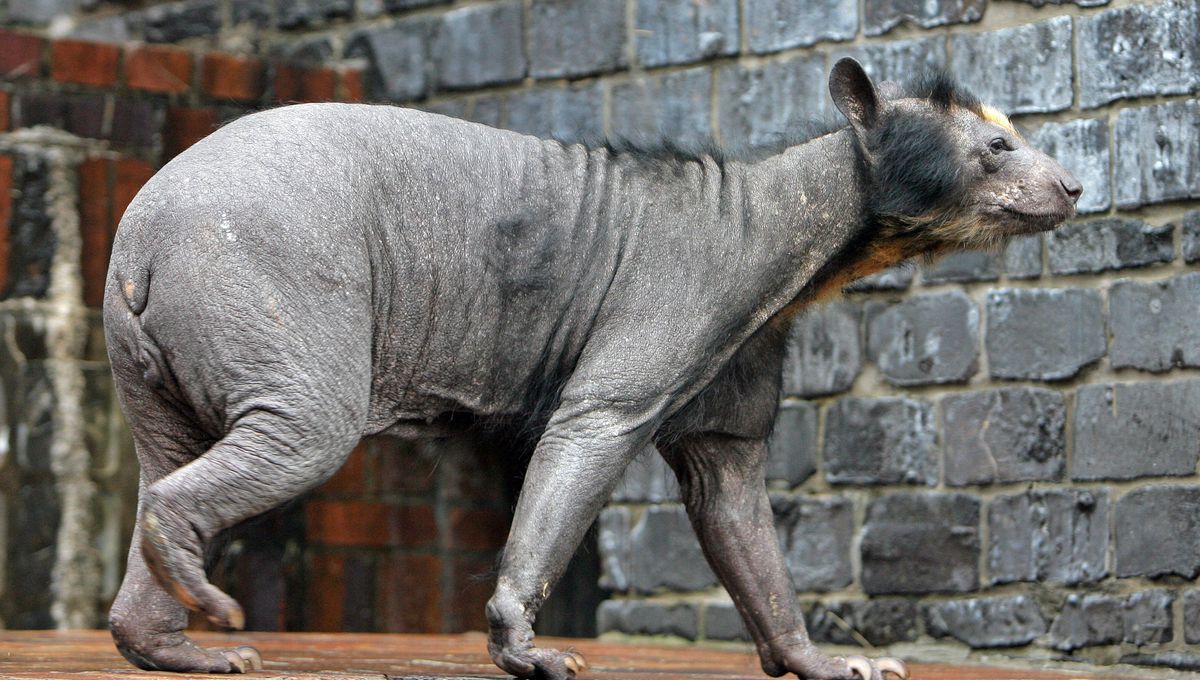
This is the real story behind the hairless bear that often circulates online and pops up on newsfeeds. You might have seen its image accompanied by sensational and misleading headlines, including the absurd notion that it’s a “new species” thriving in the ruins of Chernobyl.
But the truth is far less mysterious and far more tragic: this is a spectacled bear, a vulnerable and solitary species, likely struggling to cope with the unnatural conditions of life in captivity.
What does a hairless bear look like?
The story of the hairless bears first made headlines in 2009. A handful of media outlets reported that three female spectacled bears (Tremarctos ornatus) at Leipzig Zoo in Germany were all suffering from varying degrees of baldness.
The worst affected was a poor soul named Dolores who had lost practically all of her once-thick shaggy coat except for a sparse tuft on her head and upper back.
What happened to the hairless bear?
Animal welfare experts speculated whether it had something to do with the conditions of being in captivity. With further investigation, it was revealed that several other bears being held at European zoos were suffering from a similar ailment.
“I suggested that feeding and climate can both be a factor because they are tropical animals that we have relocated to our climates,” Gerard Baars, director of the International Bear Foundation, told the BBC World Service in 2009.
“The bears should be kept indoors and they should make an imitation of a tropical climate with hot temperatures, humidity, straw, and bedding on the floor. We in zoos are not very good at imitating natural seasonality,” he added.
Speaking to IFLScience, Leipzig Zoo confirmed that Dolores died in March 2011. They noted that the underlying cause of her hair loss was never officially identified, commenting: “Up to now, there was no breakthrough which could explain this phenomenon.”
Spectacled bear
The species, also known as the South American bear or the Andean short-faced bear, is the basis of the beloved children’s character Paddington Bear. They are native to a thin strip of the Andes Mountains that runs down South America through parts of Venezuela, Colombia, Ecuador, Peru, Bolivia, and Argentina.
In their natural habitat, they face a myriad of threats to their existence, namely poaching and habitat loss, and are considered vulnerable to extinction by the IUCN Red List [PDF]. To aid their survival, many zoos have taken in members of the species, aiming to support conservation efforts and improve their chances of recovery.
Bears in captivity
However, all bear species are known to experience significant stress in captivity. These highly intelligent animals require vast territories to roam, which many zoos can not accommodate. Stressed by their limited surroundings, captive bears will often resort to abnormal behaviours, such as repetitive pacing around their enclosure or swaying from side to side.
Crucially, spectacled bears are solitary animals that only come into contact with others during mating season. Yet in captivity, they are often confined together in shared enclosures – an unnatural arrangement that can lead to chronic stress and hormonal imbalances.
A peer-reviewed study by San Diego Zoo published in 2019 argued that the alopecia (hair loss) seen in captive Andean bears is a “symptomatic response to the long‐term social housing”. They found that the condition primarily impacts females of the species and is surprisingly common among captive spectacled bears. In North American zoos, almost a third of the females they came across were suffering from some form of hair loss.
“Even though not all socially housed females were affected by the syndrome, the only characteristics shared by all affected bears is that they were all females, socially housed with conspecifics. We therefore hypothesize that the alopecia syndrome in Andean bears may be only the most obvious symptom of endocrine abnormalities or autoimmune responses caused by the long‐term social housing of bears that would not otherwise live in groups,” the study reads.
The solution, the researchers said, is that female Andean bears should only be housed with other adults if and when females actively choose to cohabitate with others, respecting their natural inclination for lonesome living.
The issues of keeping animals in captivity are balanced with the need to preserve species that are imperiled in the natural world (too often through human actions). Dolores the hairless bear is a stark reminder that sometimes those efforts, however well-intentioned, come at a huge cost to the individual animals themselves.
Source Link: Hairless Bear: The True Story Behind The Viral Image Of A Bald Bear